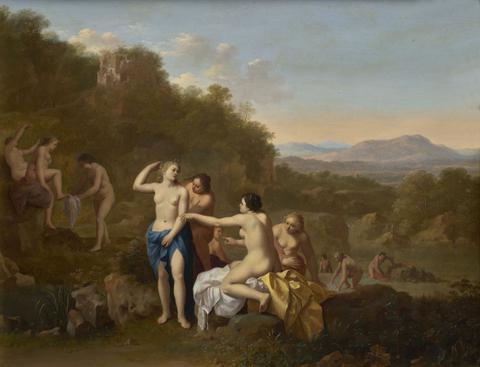
Diane et ses suivantes au bain
Cornelis van Poelenburch (1594-1595 Utrecht - 1667 Utrecht)
1640 - 1650
Huile sur cuivre ; monogrammé « CP » en bas au centre ; 33,8 x 43,7 cm
Provenance :
Paris, collection Jean-Baptiste-Pierre Le Brun (en 1793) ; Los Angeles, collection Miklós Rózsa ; New York, Sotheby's, 11 janvier 1996 ; New York, Sotheby's, 25 janvier 2008 ; Orléans, collection privée ; Paris, Artcurial, 14 novembre 2017.
Bibliographie :
Jean-Baptiste-Pierre Le Brun, Galerie des peintres flamands, hollandais et allemands, vol. I, Paris, 1793, p. 42-43 (gravé par Joseph de Longueil) ; Luuk Pijl, « Cornelis van Poelenburch, 1594/95–1667 : The Paintings, N. Sluijter-Seijffert », dans The Burlington Magazine, n°1379, février 2018, p. 160-161.
Bibliographie comparative : Nicolette Sluijter-Seijffert, Cornelis van Poelenburch, 1594/95 -1667 : The Paintings, Amsterdam, John Benjamins Publishing Company, 2016.
Les « italianisants » forment un courant distinctif de la peinture hollandaise du 17ème siècle. « Impressionnés », au sens photographique du terme, par la lumière italienne, ils en imprégnèrent leurs paysages, scènes de genre, représentations bibliques ou mythologiques, y compris après s’en être retournés. Poelenburch est considéré comme le plus important de la première génération de ces peintres. Cofondateur de la confrérie des Bentvueghels, les peintres du Nord menant à Rome la vie de bohème, il y prit le surnom de « Satiro », le Satyre, non sans lien sans doute avec les nus féminins qui peuplaient son œuvre, et peut-être sa vie. Il passa huit ans à Rome (1617-1625), et le reste de sa vie (hormis deux séjours en Angleterre, où l’appelait Charles I) à Utrecht.
Sa popularité fut immense jusqu’au début du 19ème siècle comme en témoigne la présence de ce tableau dans la collection de Jean-Baptiste-Pierre Le Brun, que l’historien d’art Francis Haskell désigne comme « le dernier, et peut-être le plus grand de la longue lignée distinguée des marchands amateurs français du 18ème siècle » (La Norme et le caprice, Paris, 1986). Le Brun le fit graver en 1793, dans un ouvrage fondamental pour l’histoire de l’art et du goût, la Galerie des peintres flamands, hollandais et allemands, avec le commentaire « un des plus beaux pour le faire » (c’est-à-dire la facture).
De fait, dans cette œuvre de la maturité, probablement les années 1640, la mythologie n’est plus qu’un prétexte, et la peinture seule est maîtresse de la perception, presque autant que dans les Baigneuses de Cézanne. Poelenburch y combine un savant travail des plans et un subtil accord de couleurs, particulièrement le blanc, bleu et jaune des draperies.
Un Paysage aux baigneuses, cuivre de dimensions identiques, presque un pendant, figure dans la collection du Getty Museum. Notre tableau a séjourné, lui aussi, à Los Angeles, dans la collection de Miklós Rózsa, compositeur américain d’origine hongroise, auteur de la musique d’une centaine de films hollywoodiens, dont Ben Hur.
